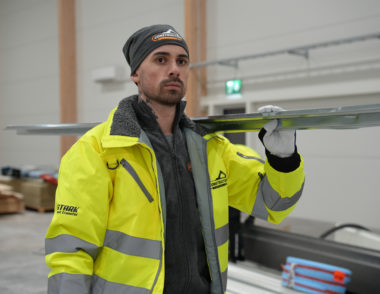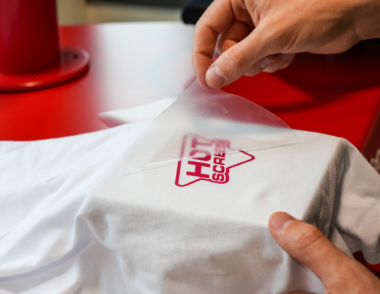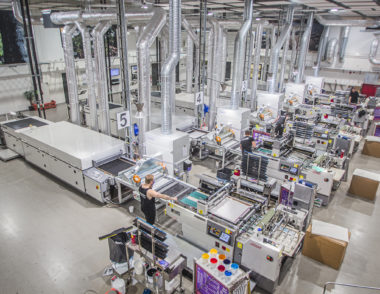About this article
Categories
Sometimes it can be hard to know exactly how you should be configuring your file before sending it for printing. In some cases, we can’t use the files we get with our orders or the files make it harder to achieve a high-quality result. We have therefore produced a checklist that customers like you should bear in mind when creating your motif or configuring your file for printing.
You might upload a monochromatic logo to our webshop in JPG format so that you can order transfer prints, for example, but because it’s a JPG, our ordering tool doesn’t recognise the colours and so it automatically sets up it as a Process which is our way of printing multi-coloured prints like portraits, logos with shading, or logos with more than 7 colours.
Start by opening the file in your image manipulation software, ideally Adobe Illustrator or a similar program. Next, make sure your file is converted to paths.
*It is normal that lines and outlines around the logotype are not converted to paths*
Convert your file to paths by selecting the entire logo, clicking on Object in the top panel and then clicking Finish. If the file was not entirely converted to paths, a pop-up will appear that looks like this:
Finish your design in Illustrator
If this pop-up appears, click OK and there you have it, your finished logo!
Finished=Converted to paths
When configuring a logo with text for printing, you need to convert your text to closed paths before saving. So that we, as the recipient of your logo, can see what your font looks like, there needs to be closed paths and non-editable text in your file.
If your text has not been converted to paths and we don’t have the exact font you used, the result might look something like this, even though you have used an entirely different font, perhaps in italics or in blue:
In order to see exactly what your logo should look like, the recipient needs to have your font installed on their computer, otherwise the text will be highlighted with a red box to indicate that the font could not be found.
To convert your text to vector paths, you need to select all editable text and hold down “SHIFT+CTRL+O” or alternatively highlight the text, click Object -> Finish and then OK.
Once you have done this you will have converted all your text to closed vector paths that are really good for printing.
When you configure your file for printing, it’s important that your logo doesn’t contain overly thin lines. Having a motif with a lot of small details can make it difficult to get a good print because the margins become so small that it’s impossible to print white behind them (which all our transfer prints have to have). For example, if you have a large motif with lots of small details and then you choose to reduce the size, the details will often become very small and completely unprintable.
A good rule of thumb to follow is that if your logo is black or white, you should never have lines thinner than 1.5 pt (0.7 mm) to ensure a good print result.
If your logo is a colour logo, the lines need to be at least 2 pt thick to ensure enough space for a white layer behind. This ensures that the colour retains its nuance.
The print on the left was done using a thickness of 2 pt, while the one on the right has lines thinner than 2 pt, which can create changes in the colours wherever there hasn’t been enough space for the white layer.
Anything you don’t want to be printed should be removed from the file before being sent for production. If you have guides, a background or a filter in your file, these will be retained in the file that is sent to us and sometimes it’s hard to tell what should and shouldn’t be printed.
This is even more important if you choose to place your order using our webshop ordering tool. If your file contains guides, filters or a background when it’s uploaded, the price you get will be wrong because the tool identifies all the colours and motifs in the file and uses these to calculate its price.
If you need help cleaning up your file to get rid of things you don’t want printing, we’ll be more than happy to assist. Please don’t hesitate to get in touch with our customer service team via e-mail or phone and we will help you as quickly as we can.
About this article
Written by:
Max Schelin
Categories
Related articles

Design your own print
Read more
What is the best file format for printing?
Read more

PMS Colors at Hot Screen
Read more
Remember not to have lines thinner than 2 pt to ensure a good print result for your motif!
About this article
Written by:
Max Schelin
Categories
Related articles

Design your own print
Read more
What is the best file format for printing?
Read more

PMS Colors at Hot Screen
Read more

Prints on workwear? Choose the heat transfer Stark!
Products
Tips & Tricks

The plotter print is a variation of our product Stark Heat Transfer.
Products

Learn more about the various print methods in the textile industry.
Print methods
Mon-Thu: 08.00-16.30
Fri: 08.00-15.30
Följ oss!
When you archive an article, it disappears from your webshop and is no longer orderable.
When you activate an article, it disappears from your archive and you can order it again